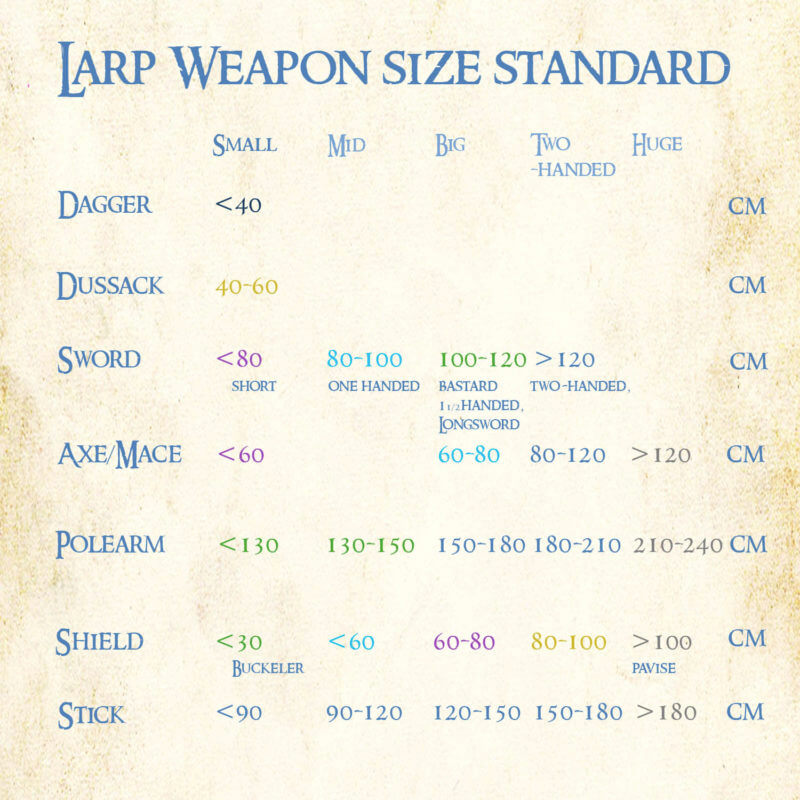Instructions for using larp weapons
- Hold the weapon by the handle and choose the appropriate force in combat.
- The weapon is not a stick, the core and the tip of the sword cannot support your weight and it can be irreparably damaged.
- If you are building a sword, place it with the tip up.
- Do not intentionally bend the weapon like a bow, do not test how much bending it can withstand, it is not built for bending, microcracks can occur, which can manifest themselves later, for example by cracking.
- The material cannot withstand contact with fire and hot surfaces. Do not expose soft weapons to temperatures above 50ºC or below -10 degrees Celsius (when the plastic becomes brittle).
- Do not leave weapons in the car in summer – surprisingly high temperatures can develop here, damaging the weapon.
- Do not store in the sun or under direct sunlight. A combination of high temperatures can occur and also prolonged exposure to UV radiation can lead to aging of the weapon.
- Store horizontally if possible and do not load other objects – the foam is flexible, but long-term loading can lead to the shapes of other objects being imprinted on it. Heavy solid objects can permanently deform the foam.
- Protect from dogs and other animals. Dogs love to chew soft things – even soft weapons. Therefore, do not try to try them and store weapons so that they do not get to them. The same goes for warehouses where mice or other rodents could get.
- Use softened weapons only to fight against soft weapons, or soft armor, shields, etc. Avoid fighting hard and sharp edges. All weapons are sensitive to the fight against unsoftened weapons, iron or simply unsoftened shields or armor. Contact with a sharp edge can damage the softened blade. If you are going into a battle with soft weapons, be sure that none of your potential opponents have unsoftened weapons (even if they have a blunt tip) or shields or armor with sharp, hard, and especially metal edges.
- Likewise, avoid hitting trees, walls, concrete, stones, various machines, etc.
- Observe the recommended use. Weapons marked only for cosplay cannot withstand real combat.
- With intensive use, some models may peel paint on the surface of the weapon. This can be solved by spraying (but be careful – see the following point), or on the elm by applying thin skin. If you want to use the weapons for training, large and long-term loads, you can strengthen their blade with a textile carpet or Kevlar, and the handle with a thin leather.
- Do not expose director or adhesives. You can damage the structure of the mass. Do not attempt to repair with adhesives or resins that will corrode. If for any reason you need to repair the weapon in an emergency, use textile tape. If you use glue, use only silicone-based adhesives, just keep in mind that this will void the warranty if the weapon is still under warranty. If you still want to modify or repair the weapon yourself, use only silicone-based adhesives. If you want to repaint the weapon, use only water-based acrylic-based paints that will not chemically react with the weapon material.
- Avoid points or cuts to the face or neck! Never attack an unprotected face, not even with a soft weapon.
- Never use a weapon that is damaged.
- Hammers, axes, baseball caps (if they weigh over 500g) – they can have a lot of kinetic energy when stretched properly. Therefore, never attack your head with them, even if it is covered by a helmet. It can be dangerous to hit the head with a baseball or a heavy ax, even if the head is protected by a helmet.
We recommend protecting your eyes with sports goggles when fighting
Size standard for larp battles

Some games may have slightly different rules, but if you stick to the table, you will usually succeed.
Weapon sizes play a role in assigning to different units and also stick to it if you want to combine a weapon (sword, ax) + shield. Color markers will help you here. E.g. for a sword 80-100 cm you can have a medium shield up to 60 cm (or smaller), if you want a larger shield (eg 80-100 cm), a fang up to 80 cm will pass to it as standard, but not a large sword. Keep this in mind when choosing weapons and its combinations.
Material and hardness of blades
The cores of weapons are most often fiberglass rods, more expensive weapons tend to have carbon cores and the highest quality weapons have composite cores. You will find all three in our offer.
The most common softening materials are latex or foam. Home-made weapons most often use microporous rubber or EVA. Microporous rubber and EVA have poorer resistance to abrasion and tearing, so they are most often glued with textile tape. Which is good for hardcore battles, but of course it detracts from the design and increases the hardness of the surface.
To measure the softness hardness of the blades, we use the Shore A scale, which suits its range well.
Latex
Latex is soft and in some respects safe, but it has several problematic properties: Some people are allergic to latex, latex is sensitive to weather – rain, heat, frost., latex ages and becomes brittle, and it is usually necessary to maintain it, for example, by treatment with silicone.
Latex blades are among the softest and have a hardness of about Shore A 15. Shore A.
There are no lax weapons in our offer, only some masks and other props are latex – the material is always marked with them due to possible allergies.
Foam
Its composition is a great alchemy and is generally one of the polyurethane foams. They can have very different properties – both different hardness and resistance to tearing and breaking. Quality foams are always soft, flexible and do not break.
The foam does not need to be maintained in any way, it is not allergenic and has a much longer lifespan against latex. However, it is not completely inert to aging. It is relatively resistant to UV light, but not 100% (which is not latex either). It is therefore better to keep the weapon somewhere in the dark not exposed to the sunlight, the pedant will get a scabbard for it and the blade will reveal only for combat. However, the foam is sensitive to temperature. It is not conducive to high temperatures (above 50-60 degrees) and becomes brittle, exposing it to frost. Therefore, do not leave it in a closed car in the summer, where the temperature can normally jump above 100 degrees, and if you are fighting outdoors on frosty days, keep in mind that the foam does not have the flexibility you are used to and will be much easier to damage. In addition, it ages faster when exposed to frost.
But the lifespan of foam weapons is proving to be very good – we have weapons that are 10 years old and still usable.
Hardness
Our weapons have a hardness of blades in the range of about Shore 15-35.
The Shore A 30 has our standard blades. It is a material that is durable, flexible and represents a good compromise for various uses.
Our newer blades with the Thowt brand have a Shore A 15-20. They are softer, they are generally better accepted at major international games (because they are as soft as latex), we are working to gradually outperform the former. They have composite cores and composite softening.
Most home-built weapons have a surface hardness around Shore A of 40-50. Which is the limit given by the textile tape.
On the market you will find a flood of mostly cheap weapons, which are nice in appearance, but the blade has a Shore A hardness of 50 or higher. At the same time, it is often a brittle foam that breaks. They can be used purely for cosplay (where, on the contrary, their mechanical properties are not a problem). You can find some of them in our shop – because of the design – just with “only cosplay” markings. Not applicable to combat.
Handles and guards
In our offer it is mostly a flexible material with Shore A 50-60, for some models we use resin about Shore A 90 – mostly for those that do not have a functional crossguard (such as a shashka) and it is practically just a clean handle.
For crossgaurds, it is always a choice. In general, flexible materials are used, which dampen the wound, but do not allow the classic work with a guard, which is known to swordsmen accustomed to steel. Their advantage is safety. And also at the vast majority of major international events is allowed only flexible crossguards. Our crossguards is all flexible.
Wooden or hard resin crossguards are popular in hardcore full force battles. It behaves more like steel. The disadvantage is that it is not completely safe in more contact combat.

